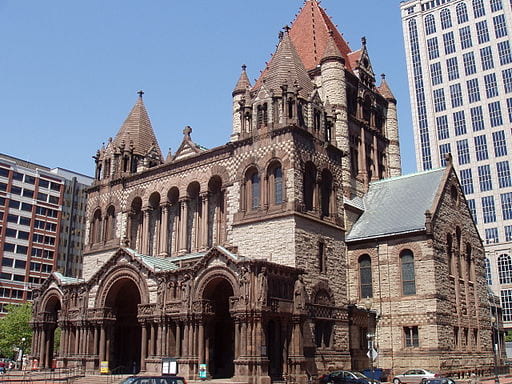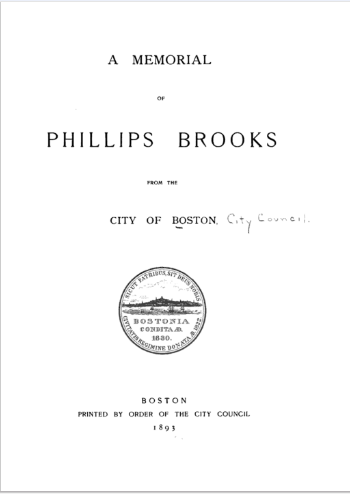by contributing editor Yitzchak Schwartz

Gilded Age America saw an uptick in the construction of spaces like Boston’s Trinity Church. They are often referenced as expressions of their builders’ wealth and status, but what can they tell us about their religious lives and ideas?
Henry Adams (1838-1918) returned home from his Grand Tour in 1860 and came of age in American elite society as the American bourgeoisie underwent the most profound cultural, social and intellectual shifts it had experienced since the Revolution. A prominent historian and writer, and a grandson of Presidents John and John Quincy Adams, Adams’ posthumously published autobiography documented his experience of these changes. Among them he counted the disappearance of religion.
Of all the conditions of his youth which afterwards puzzled the grown-up man, this disappearance of religion puzzled him most. … The religious instinct had vanished, and could not be revived …. That the most powerful emotion of man, next to the sexual, should disappear, might be a personal defect of his own; but that the most intelligent society, led by the most intelligent clergy, in the most moral conditions he ever knew, should have solved all the problems of the universe so thoroughly as to have quite ceased making itself anxious about past or future seemed to him the most curious social phenomenon he had to account for in a long life.—Henry Adams, The Education of Henry Adams (1907)
The published claims of Adams and his contemporaries have led many historians of the late-nineteenth century to characterize the period as one of religious decline. This narrative is reflected in many foundational histories of the period, which see the Gilded Age as a time of secularization. In his 1981 cultural history of late-late-nineteenth century antimodernism, historian T.J. Jackson Lears sees religion as taking on a primarily therapeutic rather than spiritual role during that time as Biblical Criticism, Darwinism and the social injustices wrought by industrial progress undermined religious authority. In The Feminization of American Culture (1977), Ann Douglas argues that the clergy became politically impotent as a result of the secularization of American life in the Gilded Age. Instead of focusing on politics, she argues, they turned their focus to the “feminine” arts and literature, abandoning efforts to speak to the American public on more pressing issues. Similarly, in his classic 1982 study of gilded age society and culture, historian Allen Trachtenberg references religion only as a source of division among the working classes and an arena of oppression for native Americans except for considering it marginally as an arena within the pursuit of culture and refinement. This narrative has deeply influenced more contemporary accounts of the period as well. In his 2003 cultural-economic history of the New York bourgeoisie, Sven Beckert only discusses religion in the context of arguing that the class transcended religious difference.
Many historians of the progressivism go even further in relegating religion at the sidelines of their narratives. Since the 1940s, historians of American religion have seen the social gospel, a late-nineteenth to early-twentieth century American religious movement that stressed social justice, as the progenitor of the progressive movement. Recent histories of the progressive era, however, do not consider religion as a force in the foundation of the progressive movement. Daniel T. Rodgers’1998 Atlantic Crossings, for example, which argues that American progressive movement was largely based on the importation of European ideas, does not consider the social gospel as a force in the movement. Many more recent works and textbooks on the progressive era similarly omit religion from their narratives. This can perhaps be partly explained by the fact that religion plays very little role in either of the two foundational studies of American progressivism, Richard Hofstadter’s 1955 Age of Reform and Robert Wiebe’s 1967 The Search for Order. More recent work on progressivism is reversing this trend. Ian Tyrell’s 2010 Reforming the World argues that American imperial expansion in the late-nineteenth century was an effort to “remake the world in terms of Protestant cultural values” that was inspired by progressive and social gospel politics. Most historians, however, continue to position religion as marginal in their work on American society and culture during the period.
This trend is unwittingly encouraged by the religious historical work on the period, which, since the 1970s, consists mainly of studies of the liberal and fundamentalist schism. Historians of American religion writing on the late-nineteenth century are primarily concerned with this period as the origins of fundamentalism. As a result, their work focuses on theologians’ reactions to scientific innovations such as Darwinism and Biblical criticism rather than religion’s place in the society and culture of the period.
How fair is this narrative of religious decline during the late nineteenth century? It is fair and accurate to argue that religion began to play a less vocal role in late nineteenth century bourgeois politics and that it occupied less time in the life of many bourgeois and working class individuals. As the historians cited above document, during this period many Americans Americans became more theologically liberal and embraced religious movements that demanded less time in Church and less restrictions outside of it. Religion certainly did not play the same kind of role it had in antebellum pro-slavery/ abolitionist politics. That said, according to sociologists Roger Finke and Rodney Stark’s 2005 study of American religious demography, the combined population of people affiliated with the three largest Protestant denominations— Methodists, Presbyterians and Baptists– in 1890 was close to fifteen million, almost a quarter of the population. This was a large market share increase from 1870 when it was close to seven million and only about seventeen percent of the population—despite that Catholics were a much smaller percentage of the population then. Lears and Douglas’ arguments that religious liberalism was a symptom of secularization do not preclude that many individuals still chose to affiliate with religious denominations. Discounting religion entirely from any narrative of late-nineteenth century culture, then, would seem unwarranted. Religion was very relevant to that society, even if its role in society changed.
 Henry Adams’ first cousin, the Episcopalian minister Phillips Brooks (1835-1893), is an example of a figure that can open a window onto how religion functioned in late-nineteenth century American society. Brooks was a scion of one of the richest families in Boston. His Unitarian parents converted to Episcopalianism when he was a boy, and after graduating from Harvard, Brooks pursued ordination and eventually was asked to lead Boston’s Trinity Church. Brooks’, a theological liberal with strong evangelical leanings, was one of the most popular preachers of his age and his published sermons were bestsellers. When he died, the City Council of Boston sponsored a small book chronicling his years in the city. Brooks did indeed live in a time of secularization. However, he had an avid following and his ideas and the ideas of similarly popular religious figures who lived at the same time can serve as valuable sources on nineteenth century thought and culture.
Henry Adams’ first cousin, the Episcopalian minister Phillips Brooks (1835-1893), is an example of a figure that can open a window onto how religion functioned in late-nineteenth century American society. Brooks was a scion of one of the richest families in Boston. His Unitarian parents converted to Episcopalianism when he was a boy, and after graduating from Harvard, Brooks pursued ordination and eventually was asked to lead Boston’s Trinity Church. Brooks’, a theological liberal with strong evangelical leanings, was one of the most popular preachers of his age and his published sermons were bestsellers. When he died, the City Council of Boston sponsored a small book chronicling his years in the city. Brooks did indeed live in a time of secularization. However, he had an avid following and his ideas and the ideas of similarly popular religious figures who lived at the same time can serve as valuable sources on nineteenth century thought and culture.
Historians ought to follow the lead of historians like Douglas and Lears, who explore the function and impact religious live and religious ideas in American society as it became more secular. This is a project that few recent scholars have engaged with. Many of the few studies that do this are studies of material culture. Historian Peter Williams, for example, argues that the nineteenth century gospel of wealth had a corollary in the gospel of art, which saw the wealthy as having a duty to patronize the arts in religious institutions. In her Material Christianity (1998), religious studies scholar Colleen McDannell explores how Philadelphia’s Laurel Hill Cemetery reflected religious ideas about landscape.
For historians of late-nineteenth and early-twentieth century material culture, the religious nature of their corpus is hard to ignore. During that period, Americans erected many of the country’s largest churches and religious monuments and produced a great deal of religious paintings, prints and works of decorative art. Historians who use written sources also stand to gain a great deal from considering religious texts from this period more carefully in their work, if not to challenge narratives of secularization, at least to enrich our understanding of its inner life.


July 23, 2018 at 12:11 pm
Reblogged this on Project ENGAGE and commented:
This is an excerpt piece from my friends at the University of Massachusetts Boston System